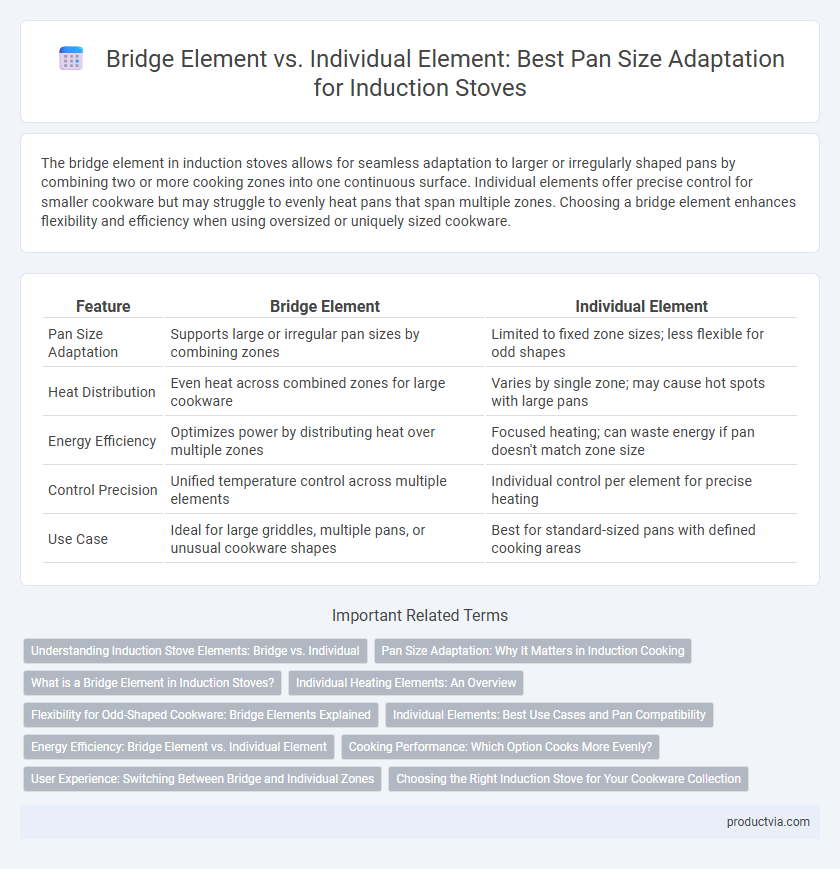The bridge element in induction stoves allows for seamless adaptation to larger or irregularly shaped pans by combining two or more cooking zones into one continuous surface. Individual elements offer precise control for smaller cookware but may struggle to evenly heat pans that span multiple zones. Choosing a bridge element enhances flexibility and efficiency when using oversized or uniquely sized cookware.
Table of Comparison
| Feature | Bridge Element | Individual Element |
|---|---|---|
| Pan Size Adaptation | Supports large or irregular pan sizes by combining zones | Limited to fixed zone sizes; less flexible for odd shapes |
| Heat Distribution | Even heat across combined zones for large cookware | Varies by single zone; may cause hot spots with large pans |
| Energy Efficiency | Optimizes power by distributing heat over multiple zones | Focused heating; can waste energy if pan doesn't match zone size |
| Control Precision | Unified temperature control across multiple elements | Individual control per element for precise heating |
| Use Case | Ideal for large griddles, multiple pans, or unusual cookware shapes | Best for standard-sized pans with defined cooking areas |
Understanding Induction Stove Elements: Bridge vs. Individual
Induction stoves feature bridge elements that combine two or more cooking zones into a larger, unified surface, allowing seamless accommodation of oversized or irregularly shaped pans. Individual elements operate independently, requiring precise pan placement to match the specific burner size for optimal heating efficiency. Choosing between bridge and individual elements impacts cooking flexibility and energy distribution, making it essential to understand these differences for effective pan size adaptation.
Pan Size Adaptation: Why It Matters in Induction Cooking
Pan size adaptation in induction stoves enhances energy efficiency by ensuring the heating element matches the diameter of the cookware, minimizing wasted energy and improving cooking performance. Bridge elements combine two or more zones to accommodate larger or irregularly shaped pans, providing flexible heating surfaces while maintaining consistent temperature across the base. Individual elements offer precise heating control for smaller pans, enabling faster response times and better temperature regulation for diverse cooking tasks.
What is a Bridge Element in Induction Stoves?
A bridge element in induction stoves combines two or more cooking zones into a single large heating surface, allowing seamless adaptation to bigger or irregularly shaped pans. This technology enhances cooking flexibility by automatically detecting pan size and distributing heat evenly across the combined zones. Unlike individual elements that heat only their designated area, bridge elements optimize energy efficiency and improve usability for oversized cookware.
Individual Heating Elements: An Overview
Individual heating elements on induction stoves offer precise pan size adaptation by activating only the specific coil beneath the cookware, resulting in optimal energy efficiency and faster heating times. Each element functions independently, allowing for customized heat zones that accommodate various pan sizes and shapes without wasting energy on unused areas. This targeted heating enhances cooking performance, reduces power consumption, and prevents overheating of surrounding surfaces.
Flexibility for Odd-Shaped Cookware: Bridge Elements Explained
Bridge elements on induction stoves create a larger, seamless cooking surface by combining two or more heating zones, providing exceptional flexibility for odd-shaped or oversized cookware that doesn't fit traditional circular elements. Individual elements restrict heating to fixed sizes, often causing uneven cooking or wasted power when using pans that don't match the element diameter. Bridge zones adapt to various pan shapes and sizes, ensuring uniform heat distribution and maximizing energy efficiency for versatile kitchen tasks.
Individual Elements: Best Use Cases and Pan Compatibility
Individual elements on induction stoves offer precise pan size adaptation by allowing each heating zone to operate independently, ensuring targeted heat distribution for varying cookware dimensions. These elements excel in households frequently using multiple smaller pans simultaneously or irregularly shaped cookware, enhancing energy efficiency and cooking performance. Their compatibility spans most pan materials with ferromagnetic bases, optimizing heat transfer and reducing energy waste compared to bridge elements.
Energy Efficiency: Bridge Element vs. Individual Element
Bridge elements on induction stoves optimize energy efficiency by seamlessly connecting two cooking zones to accommodate larger pans, reducing heat loss and ensuring consistent energy distribution across the cooking surface. Individual elements, while effective for smaller pans, may waste energy when using oversized cookware due to uneven heating and increased power consumption. Choosing a bridge element system enhances energy efficiency by matching the heating area precisely to the pan size, minimizing energy waste and maximizing performance.
Cooking Performance: Which Option Cooks More Evenly?
Bridge elements on induction stoves offer superior cooking performance by evenly distributing heat across larger or irregularly shaped pans, minimizing hot spots and ensuring uniform cooking. Individual elements can cause uneven heating when pan size extends beyond the element surface, leading to inconsistent cooking results. Choosing a bridge element is optimal for maintaining consistent temperature control and improving overall cooking evenness for various pan sizes.
User Experience: Switching Between Bridge and Individual Zones
The bridge element on an induction stove offers seamless pan size adaptation by combining two cooking zones into one larger surface, ideal for oversized or griddle pans. Switching between bridge and individual zones enhances versatility, allowing users to quickly accommodate different cookware sizes without losing power efficiency or control precision. This flexibility improves user experience by providing consistent heating and easy customization for various cooking needs.
Choosing the Right Induction Stove for Your Cookware Collection
Choosing an induction stove with bridge elements provides flexible cooking zones that accommodate larger or irregularly shaped cookware, seamlessly combining multiple elements into one heating area. Individual elements are best for standard-sized pans, offering precise heat control for each cooking zone but limiting compatibility with oversized pots. Opt for bridge elements if your cookware collection includes griddles or large pans to maximize efficiency and surface coverage.
Bridge element vs Individual element for pan size adaptation Infographic

 productvia.com
productvia.com